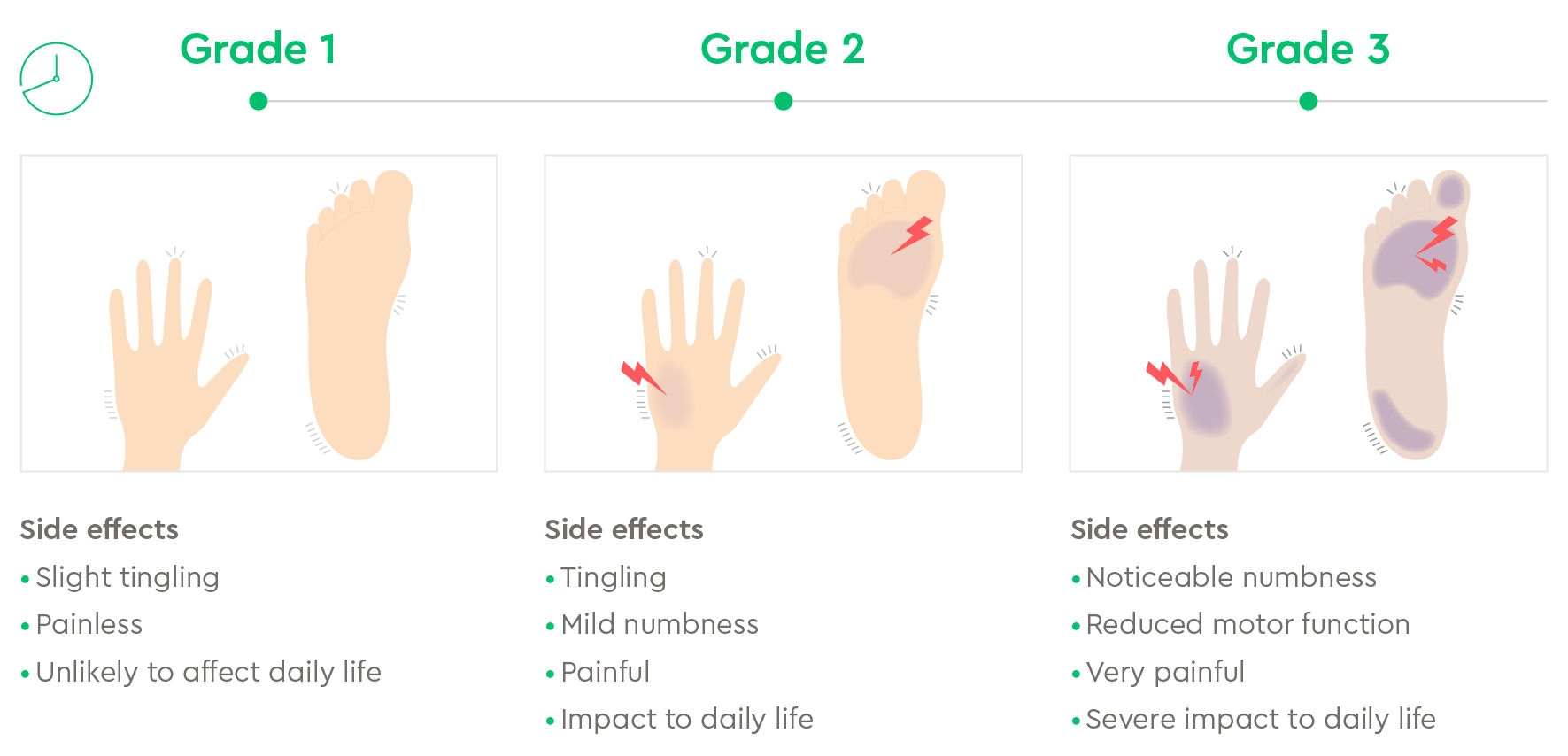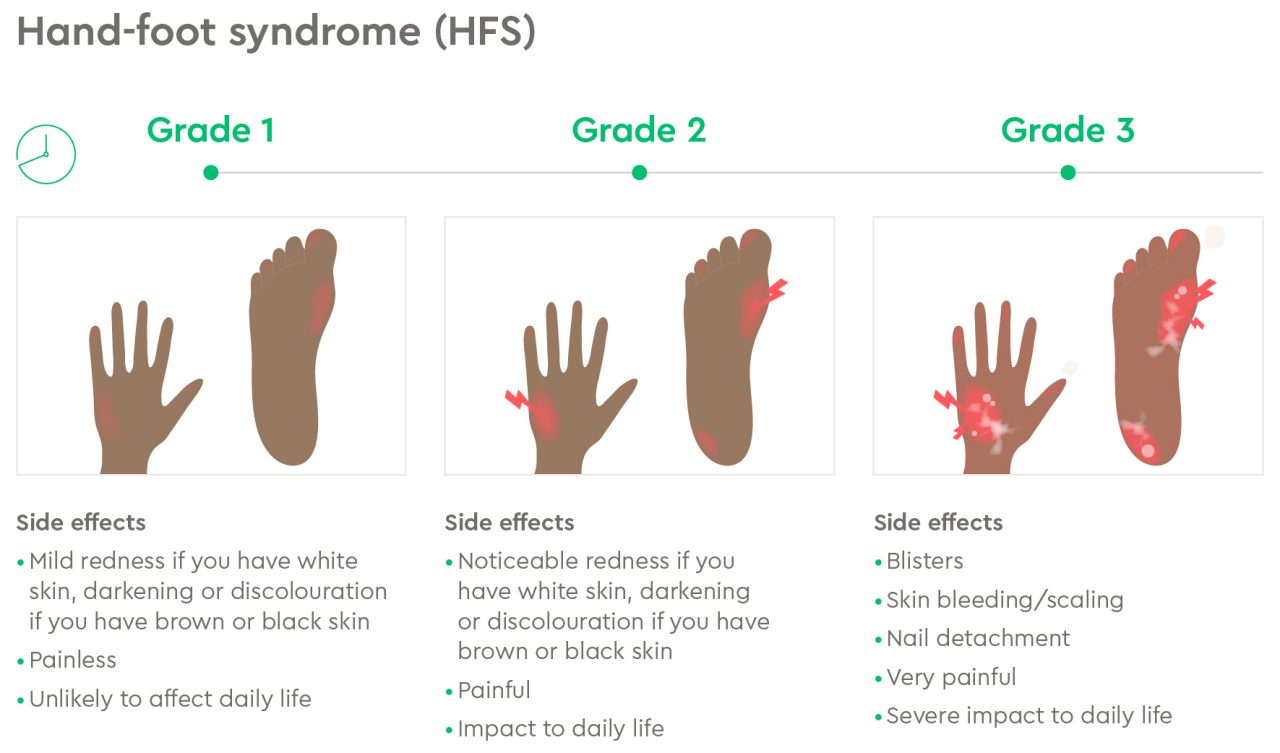- Patients
- Cancer treatments
- Chemotherapy and systemic anti cancer therapy
- Chemotherapy
- Chemotherapy side effects
- Hilotherm© ChemoCare for chemotherapy

Hilotherm® ChemoCare for chemotherapy
Hilotherm® ChemoCare is used alongside chemotherapy treatment to help prevent and reduce some chemotherapy induced side effects.
What is Hilotherm ChemoCare?
Hilotherm ChemoCare is a cooling therapy used to prevent and manage chemotherapy-induced peripheral neuropathy and hand-foot syndrome. Special cuffs cool your hands and feet before, during and after your chemotherapy to 15 - 17°C. This reduces potential damage to your nerves and tissue in those areas, by slowing the blood flow and limiting how much chemotherapy can reach them.
If you’re having a type of chemotherapy that can cause chemotherapy-induced peripheral neuropathy or hand-foot syndrome, we’ll offer you Hilotherm ChemoCare alongside your treatment, so we can work on preventing these side effects from the very first step.
If you’re already in the middle of your chemotherapy, you can still benefit from starting Hilotherm ChemoCare. It’s never too late to start.
Improving our patients’ outcomes and making treatment as comfortable as possible is important to us, that’s why we’re the first UK cancer care provider to offer Hilotherm ChemoCare.
Contact us today
If you have any questions about chemotherapy related side effects, or Hilotherm ChemoCare, contact us today. We’re here to help.
What happens during my chemotherapy session?
- About 30 minutes before your treatment starts, your chemotherapy nurse will help you put on your cooling cuffs and boots. We’ll then begin to cool your hands and feet to around 15 - 17°c
- It can take some getting used to and might feel uncomfortable to begin. We suggest wearing warm, comfortable clothing and taking paracetamol an hour beforehand. You can also bring heat pads and we have hot drinks to help you during the treatment
- You’ll keep your cuffs and boots on during your treatment to maintain cooling at 15 - 17°c
- After your treatment finishes your cuffs and boots will need to stay on for 30 minutes. If you’re already experiencing signs of chemotherapy-induced peripheral neuropathy or hand-foot syndrome this can sometimes extend to 60 minutes after your treatment
- Have a blood cancer (such as leukaemia, lymphoma, or myeloma)
- Have a medical condition resulting in a high sensitivity to cold
- Need continuous chemotherapy over the course of several days
- Have a medical condition where you liver health is affected
Your consultant will discuss your options with you.
What is peripheral neuropathy?
Peripheral neuropathy happens when the nerves in the extremities of your body, such as your hands and feet, are damaged. This can be caused by some anti-cancer drugs and is called chemotherapy-induced peripheral neuropathy (CIPN).
The symptoms you experience depend on where the nerve damage has happened, this most commonly occurs in the hands and feet. In most people with chemotherapy-induced peripheral neuropathy, the symptoms improve after their cancer treatment has ended. At GenesisCare we use Hilotherm ChemoCare to help manage these symptoms from the outset.
What causes chemotherapy-induced peripheral neuropathy?
Chemotherapy works by destroying cancer cells. But healthy cells can also be damaged or destroyed at the same time, such as the nerve cells in your hands and feet.
The nerves in your hands and feet are called peripheral nerves and they pass messages between your brain and your body. Damage to these nerves is what causes chemotherapy-induced peripheral neuropathy.
What are the symptoms of peripheral neuropathy?
The symptoms of peripheral neuropathy are outlined below and are categorised into different grades of severity.

What is hand-foot syndrome?
Hand-foot syndrome (also known as HFS or palmar-plantar erythrodysesthesia) is also a side effect of chemotherapy. It happens in the palms of your hands or the soles of your feet. Sometimes your elbows or knees can also be affected.
It can make daily activities harder, especially if left untreated. Our nurses and pharmacists have years of experience in managing this type of side effect. We also use Hilotherm ChemoCare to help reduce and manage symptoms.
What causes hand-foot syndrome?
Inside the skin on your palms and soles are small blood vessels called capillaries. These are used to deliver blood to your skin. Some chemotherapy drugs can reach these capillaries and leak into your skin on your hands or your feet. The dose and length of your treatment can affect the severity of hand-foot syndrome.
What are the symptoms of hand-foot syndrome?
Hand-foot syndrome symptoms are categorised into different grades of severity. The signs and symptoms of hand-foot syndrome can sometimes seem similar to chemotherapy-induced peripheral neuropathy.

Hand and foot syndrome treatments
Chemotherapy-induced peripheral neuropathy and hand-foot syndrome can both be treated, simultaneously using specialist cooling technology. By cooling your hands and feet, this slows the blood flow to them and limits how much chemotherapy can reach them. This reduces potential damage to your nerves and tissue in those areas.
Like chemotherapy-induced peripheral neuropathy, even if you’ve been experiencing signs of hand-foot syndrome for a while, we can still help reduce these signs. It’s never too late to start.
What can I do at home?
Even whilst using Hilotherm ChemoCare, you might be curious if there are other things you can do at home to help manage, prevent or reduce chemotherapy-induced peripheral neuropathy or hand-foot syndrome from starting. Here are some tips to help you manage symptoms at home:
- Avoid putting your hands and feet in hot water for a long time
- Take cool showers or baths where possible
- When drying your hands or feet, pat them dry instead of rubbing them
- Use gentle moisturisers on your skin before you start chemotherapy and during your treatment time
- Avoid chemicals that can be harsh on your skin, like laundry detergent or cleaning products. If you do use these chemicals, you should wear gloves that have a soft liner
- Avoid walking barefoot, try to wear socks or slippers
- Using cool, running water or ice packs, you can also cool your hands and feet in short bursts at home, for no more than 15 minutes at a time. Make sure you don’t place ice directly on your skin
For more advice and guidance, you can speak to your consultant or any one of our experienced chemotherapy nurses for tips and advice to help ease side effects.
FAQs
Regularly applying a moisturising lotion feels soothing and can help look after your skin during chemotherapy. Lotions can both prevent hand-foot syndrome and ease any symptoms if they develop.
It’s best to use fragranced lotions to avoid irritation to your skin. Evidence suggests that creams containing 10% or higher of the ingredient ‘urea’ can be effective at preventing symptoms and treating affected areas. These are readily available in pharmacies, with many different brands. You can continue to use moisturising lotion alongside Hilotherm ChemoCare; apply the cream to your skin gently and avoid excess rubbing.
Hand and foot syndrome isn’t a permanent condition. Symptoms usually ease within a few weeks after chemotherapy ends. If you’ve developed symptoms of hand and foot syndrome, it’s important to treat them. This is especially important if you’re going to have further doses of chemotherapy.
Hand and foot syndrome usually develops within a couple of weeks of starting chemotherapy but can sometimes develop after a couple of months. The length of your chemotherapy treatment and the drug you’re being treated with can affect how long hand and foot syndrome lasts.
If left untreated, it can continue throughout the course of your chemotherapy and usually stops within a few weeks of treatment ending.
Hilotherm ChemoCare can prevent hand and foot syndrome and, if you’ve already developed symptoms, this type of cooling therapy can ease and reduce your symptoms from becoming more severe.
Hand and foot syndrome usually starts with redness if you have white skin, or darkening if you have brown or black skin, and swelling on the palms of your hands and soles of your feet. Your skin may look and feel quite dry and, in more severe cases, you may develop blisters, which may bleed and crack.
Hand and foot syndrome develops particularly in pressure points, so you may notice it in the palms of your hands, fingertips, or on the soles of your feet. Hilotherm ChemoCare can help prevent these symptoms from developing or, if symptoms have already started, minimise them from getting worse.
Certain chemotherapy drugs are known to cause peripheral neuropathy and hand and foot syndrome. These include:
- 5-FU
- Capecitabine
- Docetaxel
- Paclitaxel
- Oxaliplatin
- Cytarabine
- Doxorubicin
- Liposomal doxorubicin
Peripheral neuropathy is more common when taking paclitaxel and oxaliplatin and hand and foot syndrome is more common when taking 5-FU or Capecitabine.
The best treatment for peripheral neuropathy and hand and foot syndrome is controlling the symptoms at its onset. Hilotherm ChemoCare® can be used alongside your chemotherapy to prevent or reduce the symptoms of peripheral neuropathy and hand and foot syndrome. Speak to your chemotherapy nurse if you begin to experience symptoms, and they’ll be able to advise you on the best course of action. This can also include prescribing topical creams and potentially changing or reducing your chemotherapy.
Contact us today
If you have other questions about chemotherapy related side effects, or Hilotherm ChemoCare, contact us today. We’re here to help.